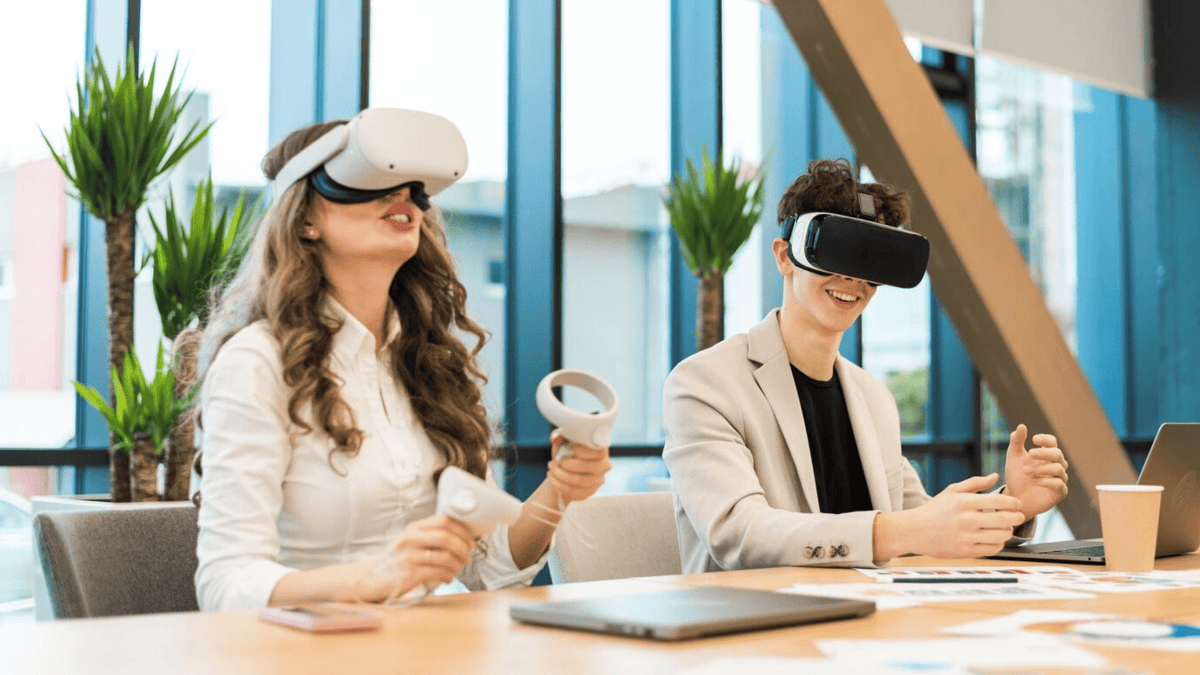The way we work has changed dramatically in recent years. Today, working from home is more than a trend; it’s a new reality. But this change isn’t limited to video calls and cloud files. Enter the “Metaverse,” a virtual world where work can be as real as the office, minus the motivation. Imagine a place where virtual meeting rooms, customizable graphics, and real-time collaboration are the main attractions. This engaging environment not only makes working from home more social but also boosts productivity, creativity, and teamwork.
In this brave new world, “going to work” can mean putting on a headset and joining a virtual office with people from all over the world. The metaverse breaks down the boundaries of geography and time zones and changes the rules. This isn’t science fiction anymore; it’s the next big evolution in how, when, and where we work.
A New Dimension to Remote Collaboration:
Traditional work-from-home options like Zoom and Slack work well, but they lack the same depth and presence as physical companies. The metaverse addresses this need by creating an immersive environment where employees can interact as avatars, explore virtual worlds, and share experiences as if they were interacting in real life. Today, it’s not enough to just see and hear; you have to be there. Teams can use digital whiteboards to brainstorm, hold virtual stand-up meetings in 3D conference rooms, or chat in a corridor lounge. This higher level of engagement creates stronger connections, smoother communication, and better collaboration. Imagine a marketing team in five countries working together in the same creative office. That’s the magic of remote work with the metaverse. No matter where you are, you can be creative anytime, anywhere, just like in real life, but with more openness and flexibility.
Increase Efficiency with Immersive Environments:
People who work from home often complain about distractions, but the metaverse offers a way to stay focused. Virtual desks are virtually distraction-free and can be customized to help you focus and get your work done efficiently. Employees can choose the best place and time to work, whether it’s serious work in a quiet digital courtyard or a team meeting in a busy conference room. This level of personalization gives employees the freedom to create a work schedule that works best for them. These environments can also be equipped with real-time success dashboards, task trackers, and AI assistants to support daily tasks. Immersive “metaverses” can also reduce “Zoom fatigue” by making communication more natural and fluid. Instead of just staring at a flat screen, employees interact with a 3D space where they can move, make gestures, and see changing images. This not only makes work more efficient but also more enjoyable.
Changing Training and Onboarding Methods:
Recruiting and training remote employees can be tricky, but “metaverses” are changing that. Now, once new employees are onboarded, they can enter a fully interactive onboarding training room to learn about company culture, meet colleagues, and even practice tasks in a realistic simulation environment. Compared to static paper or pre-recorded videos, this hands-on approach can accelerate learning and improve employee retention. In real life, interacting with customer service personnel and operating factory machinery can be risky, but virtual reality (VR) training programs can simulate these scenarios. It’s fun, easy to replicate, and inexpensive.
For offshore companies, this means everyone can get the same training regardless of their location. Most importantly, the metaverse makes people feel right at home. When new employees feel more connected and confident, they stay longer and perform better overall. Training is no longer a chore but an exciting and inspiring experience from the start.
Improve Company Culture and Teamwork:
Building and maintaining a great company culture is one of the most challenging aspects of working from home. The rise of the metaverse provides a communal space where employees can come together, celebrate successes, and have fun. In the wonderful digital world, employees can enjoy virtual coffee breaks, game nights, and team-building adventures. These activities build team spirit and camaraderie that are often lacking in the traditional online office model. Companies can also host fun and memorable virtual staff meetings, holiday parties, and awards ceremonies.
The digital world doesn’t mean people are less engaged; when used properly, it can help people build deeper connections. Virtual avatars make employees feel more open and interactions more intense. When people work from home, they often miss the relaxed and informal atmosphere that the metaverse brings. Even when people aren’t in the same room, it helps recreate the social bonds that bring teams together.
Conclusion:
The metaverse isn’t just a fantasy world from the future; it is quickly becoming the foundation of our collaboration, interconnectedness, and remote work. It combines the benefits of digital flexibility with the richness of personal communication, making it a perfect fit for our modern lives. The metaverse breaks down the last barriers to remote work. It enhances company culture and teamwork and boosts productivity and training. It enables people to fully engage from anywhere, adding a human touch to the digital workplace. As technology advances, the possibilities in this endless virtual world are likely to increase. One thing is for sure: the future of work is not bound by walls or boundaries. It happens in the metaverse.
FAQs:
1. What does the metaverse mean for remote work?
The metaverse is a 3D online world where people can work, meet, and interact using avatars and immersive environments. It is changing the way and the experience of remote work.
2. How does the metaverse help multidisciplinary teams collaborate better?
With its shared virtual space and lifelike avatars, the metaverse supports more natural and informal interactions, just like a real office, making it easier for people to communicate and collaborate.
3. Is the metaverse open to all businesses?
While many platforms are still new, they are becoming cheaper and easier to use, meaning startups and large enterprises can adopt them more often.
4. Can the metaverse replace traditional remote controls?
The point is not to replace them but to enhance them. The metaverse can work with tools like Slack and Zoom, making them more meaningful and interactive than those tools can provide on their own.
5. Does a VR headset need to work in the metaverse?
Not always. While a VR headset can enhance the experience, many metaverse apps are also accessible on a regular computer or phone, making them accessible to a wider range of people.




